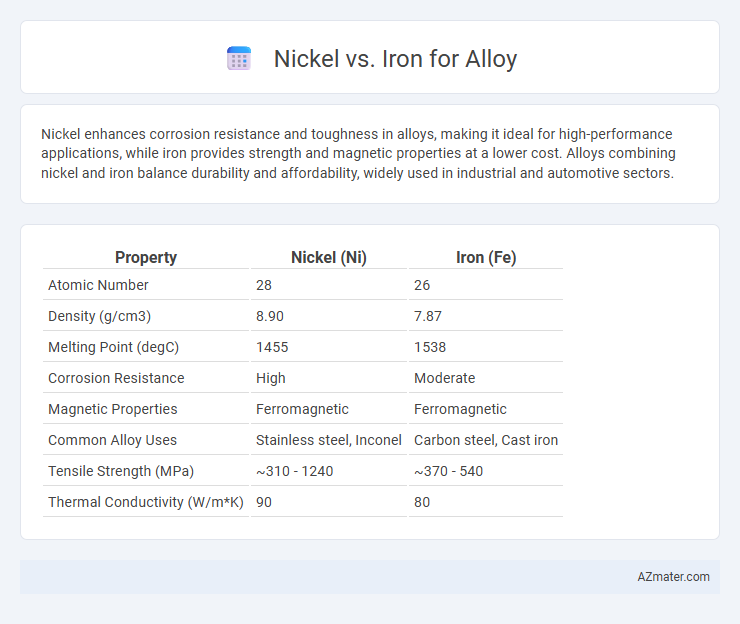Nickel enhances corrosion resistance and toughness in alloys, making it ideal for high-performance applications, while iron provides strength and magnetic properties at a lower cost. Alloys combining nickel and iron balance durability and affordability, widely used in industrial and automotive sectors.
Table of Comparison
| Property | Nickel (Ni) | Iron (Fe) |
|---|---|---|
| Atomic Number | 28 | 26 |
| Density (g/cm3) | 8.90 | 7.87 |
| Melting Point (degC) | 1455 | 1538 |
| Corrosion Resistance | High | Moderate |
| Magnetic Properties | Ferromagnetic | Ferromagnetic |
| Common Alloy Uses | Stainless steel, Inconel | Carbon steel, Cast iron |
| Tensile Strength (MPa) | ~310 - 1240 | ~370 - 540 |
| Thermal Conductivity (W/m*K) | 90 | 80 |
Introduction to Nickel and Iron Alloys
Nickel and iron alloys are essential in industries due to their exceptional strength, corrosion resistance, and thermal stability. Nickel alloys, such as Inconel and Monel, offer superior resistance to oxidation and high temperatures, making them ideal for aerospace and chemical processing applications. Iron alloys, primarily represented by various types of steel, provide a versatile balance of hardness, ductility, and cost-efficiency, widely used in construction, automotive, and manufacturing sectors.
Chemical Properties: Nickel vs Iron
Nickel exhibits superior corrosion resistance and higher oxidation stability compared to iron, making it ideal for alloys exposed to harsh environments. Its face-centered cubic (FCC) crystal structure provides enhanced ductility and toughness, while iron's body-centered cubic (BCC) structure at room temperature results in higher strength but lower malleability. Nickel's higher electronegativity and atomic radius contribute to improved alloying capabilities, promoting the formation of stable intermetallic compounds with elements such as chromium and copper.
Mechanical Strength Comparison
Nickel exhibits higher tensile strength and better corrosion resistance than iron, making it ideal for high-performance alloys in demanding mechanical applications. Iron alloys, particularly steel variants, offer excellent hardness and wear resistance but typically have lower ductility and toughness compared to nickel-based alloys. The superior mechanical strength of nickel alloys makes them preferable in aerospace and chemical processing industries where durability under stress and extreme environments is critical.
Corrosion Resistance: Which Performs Better?
Nickel outperforms iron in corrosion resistance due to its ability to form a stable, passive oxide layer that protects the alloy from oxidation and chemical attack. Iron alloys are more susceptible to rust and corrosion, particularly in moist or acidic environments, because they lack this naturally protective film. As a result, nickel-containing alloys are preferred for applications requiring long-term durability in harsh, corrosive conditions.
Heat Resistance and Thermal Stability
Nickel alloys exhibit superior heat resistance and thermal stability compared to iron alloys, maintaining structural integrity at temperatures above 900degC due to nickel's high melting point of 1455degC. Iron alloys typically begin to lose strength and oxidize rapidly past 600degC, limiting their performance in high-temperature environments. The enhanced thermal stability of nickel-based alloys makes them ideal for applications in aerospace, power generation, and chemical processing industries requiring prolonged exposure to extreme heat.
Magnetic Properties of Nickel and Iron Alloys
Nickel and iron alloys exhibit distinct magnetic properties critical in industrial applications; iron alloys generally show higher magnetic permeability and saturation magnetization, making them ideal for transformers and electric motors. Nickel alloys provide superior corrosion resistance and maintain ferromagnetic properties at lower temperatures, suitable for cryogenic and magnetic shielding applications. The combination of nickel and iron in permalloys enhances magnetic softness and reduces coercivity, optimizing performance in magnetic sensors and recording heads.
Cost and Availability in Manufacturing
Nickel generally commands a higher price than iron due to its more limited availability and complex extraction processes, impacting overall alloy manufacturing costs. Iron's abundance and widespread mining enable lower raw material expenses, making it a cost-effective choice for large-scale production. Manufacturers balance the cost premiums of nickel with its enhanced corrosion resistance and strength to determine alloy composition based on application requirements.
Environmental Impact and Sustainability
Nickel alloys offer superior corrosion resistance and durability, resulting in longer product lifespans and reduced waste compared to iron alloys, which often require more frequent replacements due to rust and degradation. The extraction and refining of nickel generally have higher energy consumption and environmental emissions than iron, but advancements in recycling technology for nickel significantly improve its sustainability profile. Sustainable alloy selection increasingly favors nickel for high-performance applications where longevity offsets its initial environmental costs.
Common Applications: Nickel vs Iron Alloys
Nickel alloys are widely used in aerospace, chemical processing, and marine industries due to their exceptional corrosion resistance and high-temperature strength. Iron alloys, particularly steel, dominate construction, automotive, and manufacturing sectors because of their superior tensile strength and cost-effectiveness. Both metals serve critical roles in alloy development where specific mechanical properties and durability are required.
Choosing the Right Alloy: Factors to Consider
Choosing the right alloy between nickel and iron hinges on factors such as corrosion resistance, strength, and temperature tolerance. Nickel alloys excel in withstanding harsh chemical environments and high temperatures, making them ideal for aerospace and marine applications, while iron alloys provide greater hardness and tensile strength suited for construction and automotive industries. Consider mechanical properties, environmental exposure, cost, and fabrication requirements to determine the best alloy for specific industrial needs.

Infographic: Nickel vs Iron for Alloy
 azmater.com
azmater.com